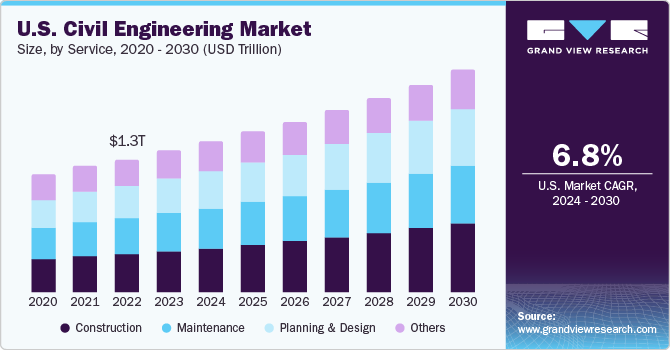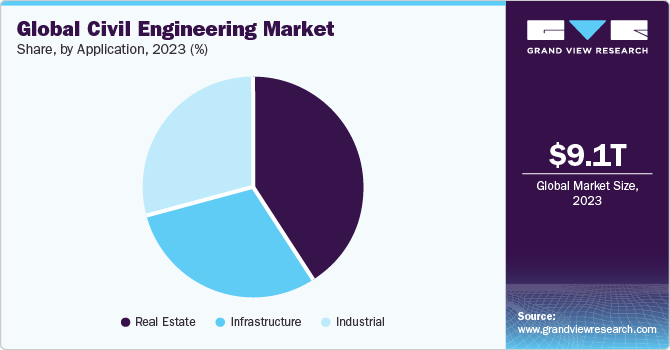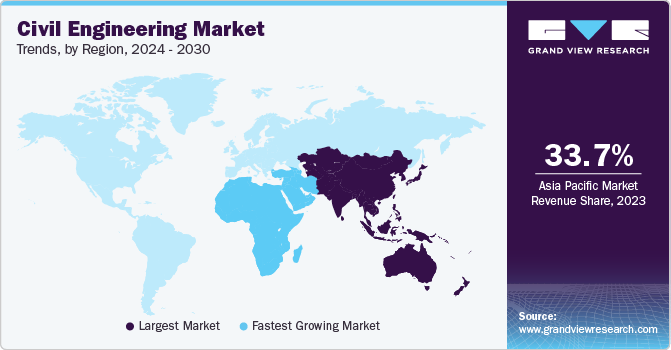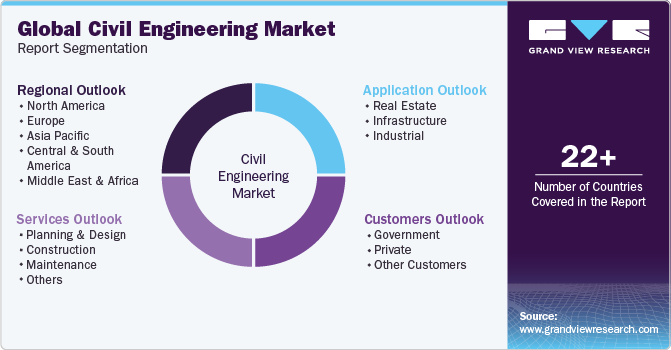
Civil Engineering Market Size, Share & Trends Analysis Report By Service (Planning & Design, Construction, Maintenance), By Application (Real Estate, Infrastructure), By Customer (Government, Private), By Region, And Segment Forecasts, 2024 - 2030
- Report ID: GVR-1-68038-131-3
- Number of Report Pages: 118
- Format: PDF, Horizon Databook
- Historical Range: 2018 - 2022
- Forecast Period: 2024 - 2030
- Industry: Advanced Materials
Civil Engineering Market Size & Trends
The global civil engineering market size was estimated at USD 9.09 trillion in 2023 and is projected to grow at a CAGR of 6.1% from 2024 to 2030. This growth is attributed to an increase in the number of infrastructure and capital projects. Additionally, increasing disposable income in emerging economies is anticipated to drive the infrastructure segment’ growth over the forecast period, thereby propelling the growth of civil engineering services in the construction industry.

Civil engineering services in North America are led by the U.S. owing to the presence of an extensively developed manufacturing industry, government initiatives to develop social infrastructure, and increased demand from the residential sector. A rising number of construction and refurbishment activities in key sectors, such as offices, educational institutes, hotels, restaurants, transport buildings, and online retail warehousing, is anticipated to fuel the growth of civil engineering within North America. In addition, the growing residential sector on account of the increasing immigration is projected to promote industry growth.
The abundant availability of raw material suppliers is expected to affect the buying power of consumers. Markets with oversupply are likely to export raw materials to import-oriented regions in order to reduce buying power. On the other hand, suppliers in import-orient shall have a larger say in pricing, thus increasing the bargaining power of suppliers.
The housing and construction industry is cyclical and can witness unforeseen fluctuations in construction activities. Such fluctuations can adversely affect product demand down the construction industry value chain. The world economy faced a severe downturn in the past years that affected developed and developing countries. This, in turn, led to a reduction in economic activities and investments in the construction sector, impacting civil engineering services worldwide.
Increasing infrastructural activities in emerging economies and a rise in refurbishment projects in developed economies are factors expected to contribute to civil engineering demand. The construction industry in Asia Pacific has been developing rapidly in recent years. The industry has witnessed numerous technological advancements and the proliferation of unique architectural designs.
Market Concentration & Characteristics
The market growth stage is medium and the pace of growth is accelerating. The civil engineering industry is characterized by a high degree of innovation.Companies are increasingly focusing on green building products because of growing awareness about the importance of energy efficiency and eco-friendly products. New sustainable construction materials such as cross-laminated timber are gaining popularity among homeowners and developers. Moreover, software such as AutoCAD, 3D Home Architect, STAAD Pro, and MS Office Suite are being used to design and manage civil engineering projects.

This market is also characterized by a high level of merger and acquisition (M&A) activity by the players. It is witnessing acquisitions and mergers of players to opt for various regional and product expansions. Such tie-ups are also beneficial for local companies since they stand a chance to gain important insights into the workings of an international corporation in addition to the financial benefits of the deal. Partnerships with industry players enable them to opt for big government projects and other big deals from a business perspective. It forces manufacturers to grab opportunities and extend their product and geographic offerings in the market.
Market is also subject to increasing regulatory scrutiny. There are several key international regulations & their impact on the civil engineering industry. The International Building Code (IBC)applies to new and existing buildings, except those residential buildings covered under the International Residential Code (IRC) and the International Residential Code applies to new and existing single- and two-family dwellings and townhouses that are not more than three stories in height.
Threat of substitutes is expected to be low over the forecast period, due to the presence of no known substitutes in the industry. Low-threat substitute products increase the attractiveness in terms of demand for civil engineering services. It also increases the profit potential of companies in the industry.
End-user concentration is a significant factor in the civil engineering industry. End-users of this market include government departments, state governments, major public & private companies, property developers, and individuals, and service providers in the industry including contractors, consultants, and builders. An architectural team is assigned the task of creating a design of buildings or structures according to the client's requirements.
Services Insights
Construction services was the largest segment and accounted for a global revenue share of 27.4% in 2023. Increasing demand for various rail structures, tunnels, bridges, and other civil works on account of growing population and traffic issues across the globe is anticipated to propel the civil engineering market growth.
Demand for planning & design services is projected to grow over the forecast period owing to the presence of multiple well-established global civil engineering companies in the industry. Planning & design is an essential part of any construction project, which ensures proper integration of design and construction process.
The maintenance service segment is anticipated to witness the fastest CAGR of 6.6% over the forecast period, as it is an essential part of civil engineering to prolong life cycle of a structure and avoid losses. It includes a number of tasks from cleaning and repairing to replacements. An increasing number of maintenance and redevelopment projects across the globe is anticipated to promote service growth in civil engineering.
Other services include renovation activities, retrofitting, reconstruction, and alterations made to existing structures. Increasing renovation activities owing to the rising need to prolong the life of a building structure is expected to aid the growth of civil engineering. Rising installations of energy-efficient products are anticipated to further drive the market growth.
Application Insights
The real estate segment accounted for a global revenue share of 40.7% in 2023 and is expected to witness significant growth over the forecast period. The rising purchasing power and consumer confidence are fueling the recovery of housing construction including both new constructions as well as renovation. This is expected to result in overall industry growth for civil engineering.

The infrastructure segment is estimated to register the fastest CAGR of 6.7% from 2024 to 2030. Increasing public and private investments in infrastructure project development including railways, roads, airports, waterways, and others are projected to drive segment growth over the forecast period. In addition, a rising inclination towards the design and development of flexible infrastructure is expected to propel the infrastructure application growth.
The industrial application segment is expected to witness a significant CAGR of 6.3% over the forecast period. Increasing manufacturing activities coupled with rising demand for industrial infrastructure including R&D, manufacturing, processing facilities as well as warehouses are expected to result in rising demand for civil engineering services across the globe.
Market players involved in engineering, design, and construction of industrial facilities offer a broad range of services to manufacturing companies, oil & gas industry, energy & power, aviation, and several other industries for development and maintenance, thereby driving the industry growth for civil engineering over the forecast period.
Customers Insights
The government was the largest customer segment and accounted the global revenue share of 41.3% in 2023. Favorable government policies for the development of railways and road infrastructure, as well as renovation of public infrastructure buildings and their maintenance, are projected to benefit the segment growth.
Rising public spending on housing projects with increasing investments in new construction and renovation is expected to have a major impact on the market for civil engineering across the globe. In addition, rising investments from public sector in the non-residential segment suggest several government programs and policies supporting the development of non-residential construction.
Private sector, including construction contractors, individuals, and real estate developers, is also a major customer of civil engineering services. Increasing investment by private companies in construction activities including housing projects and the development of healthcare centers & new schools indicates the rising demand for civil engineering services from private institutions.
Major infrastructure projects rely on both public and private funds. Projects, which are conducted jointly between public and private companies encourage the private sector to engage in high-budget infrastructure projects. Therefore, it is expected to propel the demand for civil engineering during the forecast period.
Regional Insights
The demand outlook for North America civil engineering market is favorable, with public and private investments focusing on longer-term infrastructures such as new manufacturing plants. In addition, industrial sector in North America is also expected to benefit from the new policy reforms. This is expected to boost the industrial construction in the region, thereby driving the demand for civil engineering services over the forecast period.
U.S. Civil Engineering Market Trends
The U.S. accounted for the largest revenue market share in 2023, with a slow recovery in residential and commercial constructions. However, declining infrastructure investment poses a major concern to the country's construction sector. The U.S. has failed to address its deficiency in infrastructure through measures like the construction of roads, bridges, airports, and waterways mainly because of the lack of funding.

The civil engineering market in Mexico is witnessing growth due to implementation of national development plan by Mexico government which is known asNational Infrastructure Program (PNI) to boost infrastructural growth in the country as a strategic move to increase productivity and improve competitive market of construction industry. PNI is anticipated to reduce regional differences across the country and increase overall standard of living in Mexico, resulting in an ascending market for civil engineering.
Asia Pacific Civil Engineering Market Trends
Asia Pacific held a revenue share of 33.7% of the global market in 2023. The region is expected to observe the most extreme development rate over the conjecture time frame. While many organizations are situated in the U.S., Asia Pacific has seen a substantial rise in the expansion of the civil engineering sector. Organizations based out of the U.S. are setting up businesses in nations like India & China that offer tax breaks and decreased assembling costs.
The civil engineering market in China has bounced back from the effects of the COVID-19 pandemic, supported by ongoing industrialization and urbanization projects in the country. Additionally, resurgence in foreign investment funding for infrastructural development, and increasing disposable incomes of the population is expected to further boost the market growth.
The India civil engineering market is anticipated to grow at a rapid pace over the forecast period owing to government initiatives such as “Make in India”. Furthermore, positive development in the regional economic conditions is likely to lead to the growth of residential and commercial construction projects, which in turn is conducive to market growth.
Europe Civil Engineering Market Trends
The civil engineering market in Europe is expected to grow during the forecast period. The construction sector is a major contributor to the overall GDP in almost all European countries. In addition, positive signs in public and private debt are contributing to the growth of the construction industry, which, in turn, is expected to contribute favorably to market growth.
The civil engineering market in Germany is one of the biggest consumers of civil engineering in Europe for the year 2023. The construction sector is witnessing a boom due to various government initiatives in the form of tax incentives related to real estate. These advantages and are anticipated to benefit the civil engineering industry in Germany.
Middle East & Africa Civil Engineering Market Trends
The construction industry in Middle East & Africa is expected to witness a rebound growth over the forecast period owing to the expansion of oil production and increase in private investments. Moreover, a rise in investment by the governments of Saudi Arabia, the UAE, and Qatar in construction projects in order to boost economic growth in their respective countries is expected to drive the construction industry, thereby augmenting the demand for civil engineering services.
The Saudi Arabia civil engineering market is experiencing boom due toongoing infrastructuralprojects initiated by the Government of Saudi Arabia such as National Investment Strategy. In October 2021, Kingdom of Saudi Arabia declared KSA Vision 2030 goals that includes renewable energy, manufacturing, logistics and transportation, healthcare, and digital infrastructure are among major industries covered by National Investment Strategy of the country.
Key Civil Engineering Company Insights
Some of the key players operating in market include AECOM; Jacobs Engineering Group, Inc.; Amec Foster Wheeler plc; United States Army Corps of Engineers; and HDR Inc.:
-
AECOM, along with its subsidiaries, designs, finances, and operates infrastructural assets across the world. Its design and consulting services segment offers consulting, planning, engineering designs, and construction management services for industrial & commercial applications and government projects of transportation and energy.
-
Jacobs Engineering Group, Inc. offers technical and construction services. It is engaged in engineering, interiors, designing, architecture, planning, scheduling, estimating, accounting, safety, and other related services. The company also offers operational & maintenance services, field construction, consulting, and environmental remedial construction services.
SNC-Lavalin; Fluor Corporation; Galfar Engineering & Contracting SAOG; and Stantec Inc. are some of the emerging participants in the market.
-
SNC-LavalinFluor Corporation is one of the major players in the infrastructure ownership. It deals with fully integrated professional services and project management. The company offers solutions for capital investment, design, engineering, consulting, construction, operations, and maintenance for various industries such as oil & gas, mining, infrastructure, metallurgy, power, and energy.
-
Galfar Engineering & Contracting SAOG (Galfar), along with its subsidiaries, is engaged in manufacturing, construction, equipment hires, and personnel training in the Sultanate of Oman, India, and other GCC countries. The company is involved in the construction of residential, commercial, government, and educational buildings.
Key Civil Engineering Companies:
The following are the leading companies in the civil engineering market. These companies collectively hold the largest market share and dictate industry trends.
- AECOM
- Amec Foster Wheeler plc
- United States Army Corps of Engineers
- SNC-Lavalin
- Jacobs
- Galfar Engineering & Contracting SAOG (Galfar)
- Fluor Corporation.
- HDR, Inc.
- Tetra Tech, Inc.
- Stantec, Inc.
Recent Developments
-
In January 2024, an AECOM-led joint venture called Vermont Corridor Partners (VCP) led the Vermont Transit Corridor Planning and Environmental Study. The study recommends a multi-faceted BRT and rail improvement plan along Vermont Avenue, LA Metro's second-busiest transit corridor running from Hollywood Boulevard to 120th Street. This joint venture will be aimed at the planning, design, and implementation, with mobility access, equity, and community priorities at the forefront.
-
In December 2023, Jacobs partnered with a non-profit organization Bridges to Prosperity in order to construct a suspended footbridge over a river for the safety and convenience of the surrounding communities. The team worked on every stage of the project, from filling the abutment with rock and concrete to creating approach ramps hoisting cables and setting the sag, assembling and launching swings over cables, decking, hand installation of fencing, and painting towers.
-
In December 2023, Fluor Corporation was contracted by Dow to construct the world's first Net-Zero Scope 1 and Net-Zero Scope 2 Integrated Ethylene Cracker and Derivatives Complex in Fort Saskatchewan Alberta, Canada. Dow’s current manufacturing facilities are being expanded and refurbished as part of the overall program.
Civil Engineering Market Report Scope
|
Report Attribute |
Details |
|
Market size value in 2024 |
USD 9.58 trillion |
|
Revenue forecast in 2030 |
USD 13.70 trillion |
|
Growth rate |
CAGR of 6.1% from 2024 to 2030 |
|
Base year for estimation |
2023 |
|
Historical data |
2018 - 2022 |
|
Forecast period |
2024 - 2030 |
|
Report updated |
June 2024 |
|
Quantitative units |
Revenue in USD trillion and CAGR from 2024 to 2030 |
|
Report coverage |
Revenue forecast, company ranking, competitive landscape, growth factors, and trends |
|
Segments covered |
Service, application, customers, region |
|
Region scope |
North America; Europe; Asia Pacific; Central & South America; Middle East & Africa |
|
Country scope |
U.S.; Canada; Mexico; UK; Germany; France; China; India; Australia; Indonesia; Brazil; Saudi Arabia; UAE; Qatar |
|
Key companies profiled |
AECOM; Amec Foster Wheeler plc; United States Army Corps of Engineers; SNC-Lavalin; Jacobs; Galfar Engineering & Contracting SAOG (Galfar); Fluor Corporation.; HDR Inc.; Tetra Tech Inc.; Stantec Inc. |
|
Customization scope |
Free report customization (equivalent up to 8 analysts’ working days) with purchase. Addition or alteration to country, regional & segment scope. |
|
Pricing and purchase options |
Avail customized purchase options to meet your exact research needs. Explore purchase options |
Global Civil Engineering Market Report Segmentation
This report forecasts revenue growth at global, regional, and country levels and provides an analysis of the latest industry trends in each of the sub-segments from 2018 to 2030. For this study, Grand View Research has segmented the civil engineering market report based on service, application, customer, and region:

-
Services Outlook (Revenue, USD Trillion, 2018 - 2030)
-
Planning & Design
-
Construction
-
Maintenance
-
Others
-
-
Application Outlook (Revenue, USD Trillion, 2018 - 2030)
-
Real Estate
-
Infrastructure
-
Industrial
-
-
Customers Outlook (Revenue, USD Trillion, 2018 - 2030)
-
Government
-
Private
-
Other Customers
-
-
Regional Outlook (Revenue, USD Trillion, 2018 - 2030)
-
North America
-
U.S.
-
Canada
-
Mexico
-
-
Europe
-
UK
-
Germany
-
France
-
-
Asia Pacific
-
China
-
India
-
Australia
-
Indonesia
-
-
Central & South America
-
Brazil
-
-
Middle East & Africa
-
Saudi Arabia
-
UAE
-
Qatar
-
-
Frequently Asked Questions About This Report
b. The global civil engineering market size was estimated at USD 9.09 trillion in 2023 and is expected to reach USD 9.58 trillion in 2024.
b. The global civil engineering market is expected to grow at a compound annual growth rate (CAGR) of 6.1% from 2024 to 2030, to reach USD 13.70 trillion by 2030.
b. The construction services segment dominated the civil engineering market with a share of 27.4% in 2023, owing to the rising demand for the building of various structures, including residential and commercial buildings, public infrastructure including healthcare facilities, recreational parks, community centers, and bus stations & railway stations, airports.
b. Some of the key players operating in the civil engineering market includhttps://gvr.probitcrm.com/en/v1/sales/order/researche AECOM, Amec Foster Wheeler plc, United States Army Corps of Engineers, SNC-Lavalin, Jacobs Engineering Group, Inc., Galfar Engineering & Contracting SAOG (Galfar), Fluor Corporation, HDR, Inc., Tetra Tech, Inc., Stantec, Inc.
b. The key factors that are driving the civil engineering market include increasing urbanization and industrialization across the globe. In addition, the introduction of new machinery and technologies such as using prefabricated modules, pre-engineered buildings in the implementation of large construction projects while maintaining building standards are anticipated to further benefit the market growth.
We are committed towards customer satisfaction, and quality service.
"The quality of research they have done for us has been excellent."




